Reconstructing the Relative Ice-Flow Chronology South of Lake Mistassini in Canada from New Ice-Flow Indicator Mapping
Abstract
:1. Introduction
2. Study Area
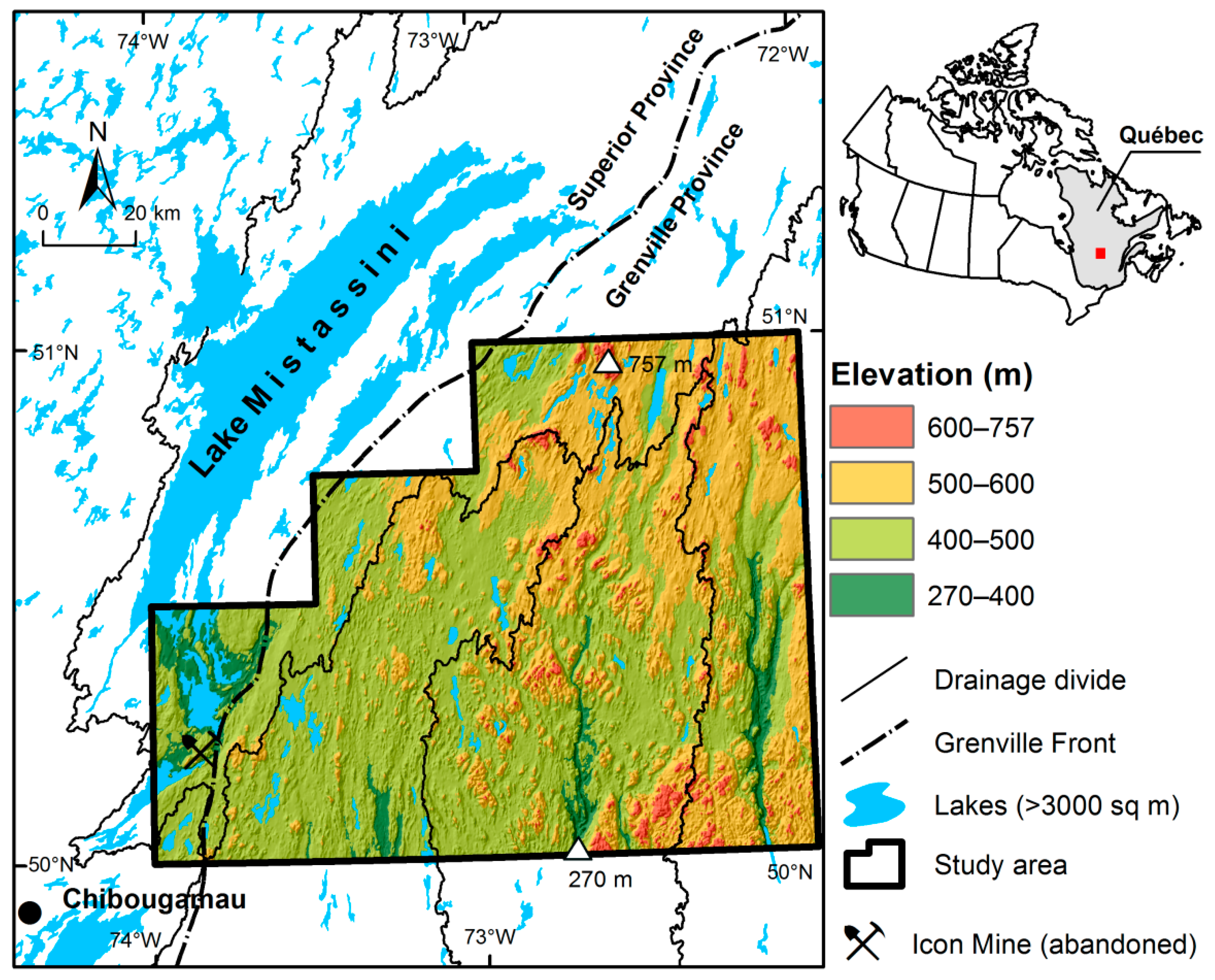
3. Materials and Methods
3.1. Small-Scale Glacial Features
3.2. Large-Scale Glacial Features
3.3. Data Collection and Processing
4. Results
4.1. Ice Flow SE
4.2. Ice Flow SSW
4.3. Ice Flow SW
4.4. Ice Flow SSE
4.5. Ice Flow S
4.6. Till Fabric
5. Discussion
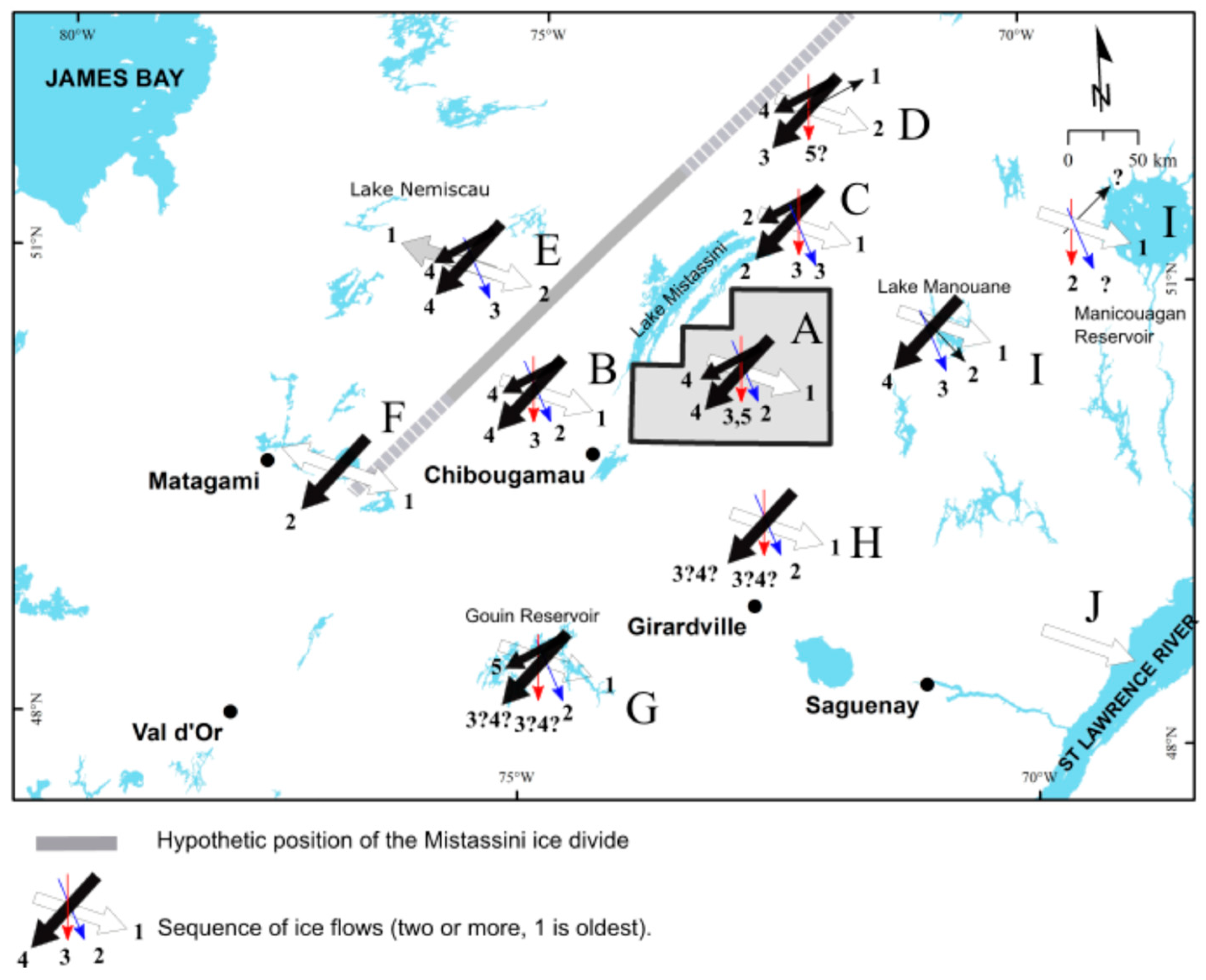
6. Conclusions
Author Contributions
Funding
Data Availability Statement
Acknowledgments
Conflicts of Interest
References
- Bouchard, M.A.; Cadieux, B.; Goutier, F. L’origine et les caractéristiques des lithofaciès du till dans le secteur nord du lac Albanel, Québec: Une étude de la dispersion glaciaire clastique. Can. Inst. Min. Metall. 1984, 34, 244–260. [Google Scholar]
- Martineau, G.; Bouchard, M.; Lacroix, P. Aspects de la Géologie du Quaternaire de Chibougamau; Québec MB 84-13; Ministère de l’Énergie et des Ressources: Québec, QC, Canada, 1984; p. 24.
- Bouchard, M.A. Géologie des Dépôts Meubles de la Région de Témiscamie, Territoire du Nouveau-Québec; MM 83-03; Ministère de l’Énergie et des Ressources: Québec, QC, Canada, 1986; p. 90.
- Prichonnet, G.; Beaudry, L. Évidence d’un écoulement glaciaire sud, antérieur à l’écoulement sud-ouest du Wisconsinien supérieur, région de Chapais, Québec. Rech. En Cours. Partie C. 1990, 90, 331–338. [Google Scholar]
- Veillette, J.J. Ice flow chronology and palimpsest, long-distance dispersal of indicator clasts, north of the St. Lawrence River Valley, Québec. Géographie Phys. Et Quat. 2004, 58, 187–216. [Google Scholar] [CrossRef]
- Cadieux, B. La Dispersion Glaciaire des Fragments de Roches dans la Région du lac Mistassini, Québec. Master’s Thesis, Université de Montréal, Montréal, QC, Canada, 1986; p. 167. [Google Scholar]
- DeCorta, H. Les Dépôts Quaternaires de la Région lac Rohault-Lac Boisvert (sud de Chibougamau). Aspects de la Dispersion Glaciaire Clastique. Master’s Thesis, Université du Québec à Montréal, Montréal, QC, Canada, 1988; p. 124. [Google Scholar]
- Paradis, S.J. Géologie des formations en Surface, Lac Chibougamau, Municipalité de Chibougamau, Québec; Carte 2062A, échelle 1/100000; Commission Géologique du Canada: Ottawa, ON, Canada, 2004. [CrossRef]
- Warren, B. Dépôts Meubles de la Région de la Baie-du-Poste, Comtés d’Abitibi-Est et de Roberval; DP-267; Ministère des Richesses Naturelles: Québec, QC, Canada, 1974; p. 8.
- Dilabio, R.N.W. Glacial dispersal of rocks and minerals at the south end of Lac Mistassini, Québec, with special reference to the Icon dispersal train. Geol. Surv. Can. 1981, 3, 46. [Google Scholar]
- Bostock, H.S. Physiographic Regions of Canada; “A”Series Map 1254A; Geological Survey of Canada: Ottawa, ON, Canada, 1970. [CrossRef]
- Neilson, J.M. La Région d’Albanel, Territoire de Mistassini; Ministère des Mines: Québec, QC, Canada, 1953; Volume 53, p. 38.
- Bergeron, R. Late Precambrian Rocks of the North Shore of the St. Lawrence River and of the Mistassini and Otish Mountains Areas, Quebec. In The Proterozoic in Canada; Gill, J.E., Ed.; Special Publication 2; Royal Society of Canada: Ottawa, ON, Canada, 1957; pp. 124–131. [Google Scholar] [CrossRef]
- Caty, J.L. Région du lac Mistassini, Québec: Stratigraphie et Sédimentologie de la Formation de Papaskwasati; DVP 423; Ministère de l’Énergie et des Ressources: Québec, QC, Canada, 1976; p. 270.
- Vézina, C.; Tremblay, A.; Leclerc, F.; Daoudene, Y. Analyse Structurale de la Zone de Cisaillement de la Rivière France et de ses Minéralisations Aurifères, Région de Chibougamau; MB 2015-04; Ministère de l’Énergie et des Ressources Naturelles: Québec, QC, Canada, 2015; p. 40.
- EL Amrani, M. Géologie des Dépôts de Surface au Nord-est de la Baie Abatagouche; Québec RP2018-03; Ministère de l’Énergie et des Ressources Naturelles: Québec, QC, Canada, 2018; p. 14. Available online: https://gq.mines.gouv.qc.ca/documents/examine/RP201806/RP201806RAP001.pdf (accessed on 9 October 2024).
- EL Amrani, M. Géologie des Dépôts de Surface au Sud-est de la Baie Abatagouche; Québec RP2018-02; Ministère de l’Énergie et des Ressources Naturelles: Québec, QC, Canada, 2018; p. 14. Available online: https://gq.mines.gouv.qc.ca/documents/examine/RP201802/RP201802RAP002.pdf (accessed on 9 October 2024).
- EL Amrani, M. Géologie des Dépôts de Surface au sud du lac Mistassini; Québec RP2018-01; Ministère de l’Énergie et des Ressources Naturelles: Québec, QC, Canada, 2018; p. 17.
- Thériault, R.; Beauséjour, S. Carte géologique du Québec; DV2012-06; Ministère de L’Énergie et des Ressources Naturelles: Québec, QC, Canada, 2012; p. 8.
- Laverdière, C.; Guimont, P.; Dionne, J. Les formes et les marques de l’érosion glaciaire du plancher rocheux: Signification, terminologie, illustration. Palaeogeogr. Palaeoclimatol. Palaeoecol. 1985, 51, 365–387. [Google Scholar] [CrossRef]
- Wintges, T. Studies on crescentic fractures and crescentic gouges with the help of close-range photogrammetry. J. Glaciol. 1985, 31, 340–349. [Google Scholar] [CrossRef]
- Clark, C. Mega-scale glacial lineations and cross-cutting ice-flow landforms. Earth Surf. Process. Landf. 1993, 18, 1–29. [Google Scholar] [CrossRef]
- Mckenzie, M.A.; Simkins, L.M.; Principato, S.M.; Garcia, S.M. Streamlined subglacial bedform sensitivity to bed characteristics across the deglaciated Northern Hemisphere. Earth Surf. Process. Landf. 2022, 47, 2341–2356. [Google Scholar] [CrossRef]
- Boulton, G. The origin of glacially fluted surfaces-observations and theory. J. Glaciol. 1976, 17, 287–309. [Google Scholar] [CrossRef]
- Millar, S.W. Fabric variability associated with periglacial mass-wasting at Eagle Summit, Alaska. Geomorphology 2012, 72, 222–237. [Google Scholar] [CrossRef]
- Santos, J.; Cunha, L. Till fabric analysis and origin of Portage Glacier Little Ice Age moraines, south-central Alaska. Polar Geogr. 2012, 35, 65–81. [Google Scholar] [CrossRef]
- Andrews, J. Techniques of till fabric analysis. Tech. Bull. Br. Geomorphol. Res. Group 1971, 6, 43. [Google Scholar]
- Benn, D. Fabric shape and the interpretation of sedimentary data. J. Sediment. Res. 1994, 64, 910–915. [Google Scholar]
- Bouchard, M.A.; Martineau, G. Southeastward ice flow in central Québec and its paleogeographic significance. Can. J. Earth Sci. 1985, 22, 1536–1541. [Google Scholar] [CrossRef]
- Daubois, V.; Lamarche, O. Géologie des Dépôts de Surface de la Région des Monts Otish, d’Eeyou Istchee Baie-James, Québec; BQ2020-01; Ministère de l’Énergie et des Ressources Naturelles: Québec, QC, Canada, 2020. Available online: https://gq.mines.gouv.qc.ca/bulletins-quaternaires/bq-otish/ (accessed on 9 October 2024).
- Prichonnet, G.; Martineau, G.; Bisson, L. Les dépôts quaternaires de la région de Chibougamau, Québec, Québec. Géographie Phys. Et Quat. 1984, 38, 287–304. [Google Scholar] [CrossRef]
- Bisson, L. Géologie des Dépôts Quaternaires du Canton de Scott, Chibougamau-Québec. Avec Applications à la Prospection Minérale. Master’s Thesis, Université du Québec à Montréal, Montreal, QC, Canada, 1987; p. 182. [Google Scholar]
- Levasseur, D.; Prichonnet, G. La dispersion clastique des débris rocheux dans les eskers et le till adjacent de la région de Chapais-Chibougamau (Québec) au Wisconsinien supérieur. Can. J. Earth Sci. 1995, 32, 590–602. [Google Scholar] [CrossRef]
- Paradis, S.J.; Boisvert, E. Séquence des écoulements glaciaires dans le secteur de Chibougamau-Némiscau, Québec. Curr. Res. Geol. Surv. Can. Ott. Pap. 1995, 1995-C, 259–264. [Google Scholar]
- El Amrani, M. Géologie des Dépôts de Surface dans la Partie SE de la Région de la Rivière Mistassini (SNRC 32H01, 32H02, 32H07 et 32H08); RP2019-03; Ministère de l’Énergie et des Ressources Naturelles: Québec, QC, Canada, 2019; p. 17.
- Martineau, G.; Bouchard, M.A.; Prichonnet, G. Southeastward ice flow in central Quebec and its implication for the location of the Laurentide Ice Sheet dispersal centers. Geol. Ass. Can. Program. Abstr. 1984, 9, 87. [Google Scholar]
- El Amrani, M.; Amine, A.; Courba, S.; Ousaid, L.; Diani, K.; Hahou, Y.; Boudad, L.; Mdiker, N. Integrating DEM and field data to unravel the impact of bedrock topography on Late Quaternary ice flows: A case study of the Lake Mistassini area, Canada. J. Earth Syst. Sci. 2024, 133, 40. [Google Scholar] [CrossRef]
- Dionne, J.C. Blocs de dolomie à stromatolites sur les rives de l’estuaire du Saint-Laurent, Québec. Géographie Phys. Et Quat. 1986, 40, 93–98. [Google Scholar] [CrossRef]
- Dionne, J.C. Erratiques de dolomie au cap Colombier, sur la haute Côte-Nord du Saint-Laurent estuarien. Géographie Phys. Et Quat. 2001, 58, 101–107. [Google Scholar] [CrossRef]
- Dionne, J.C.; Bernatchez, P. Les erratiques de dolomie sur le rivage des Escoumins, Côte-Nord de l’estuaire maritime du Saint-Laurent, Québec. Atl. Geol. 2000, 36, 117–129. [Google Scholar] [CrossRef] [PubMed]
- El Amrani, M.; Gélinas, T.K.; Carré, A. Occurrence, significance and origin of banded iron formation erratics south of lake Mistassini, Quebec, Canada. Quaternaire 2018, 29, 169–176. [Google Scholar] [CrossRef]
- Veillette, J.J.; Pomares, J.S. Older ice flows in the Matagarni-Chapais area, Quebec. Curr. Res. Part C. Commission Géologique du Canada, Ottawa, Canada. Pap. 1991, 91, 143–148. [Google Scholar]
- Daubois, V.; Dubé-Loubert, H. Géologie des Dépôts de Surface de la Région de Clova, Haute-Mauricie; RP2018-03; Ministère de l’Énergie et des Ressources Naturelles: Québec, QC, Canada, 2018; p. 28.
- Veillette, J.J.; Dyke, A.S.; Roy, M. Ice-flow evolution of the Labrador Sector of the Laurentide Ice Sheet: A review, with new evidence from northern Quebec. Quat. Sci. Rev. 1999, 18, 993–1019. [Google Scholar] [CrossRef]
- Dyke, A.S.; Prest, V.K. Late Wisconsinan and Holocene history of the Laurentide Ice Sheet. Géographie Phys. Et Quat. 1987, 41, 237–263. [Google Scholar] [CrossRef]
- Prichonnet, G. Quelques données nouvelles sur les dépôts quaternaires du Wisconsinien et de l’Holocène dans le piedmont appalachien, Granby, Québec. Comm. Géologique Can. Rech. Cours 1982, 82, 225–238. [Google Scholar]
- Hart, J.K. Subglacial erosion, deposition and deformation associated with deformable beds. Prog. Phys. Geogr. 1995, 19, 173–191. [Google Scholar] [CrossRef]
- Smith, M.J.; Knight, J. Palaeoglaciology of the last Irish Ice Sheet reconstructed from striae evidence. Quat. Sci. Rev. 2011, 30, 147–160. [Google Scholar] [CrossRef]
- Kleman, J. On the use of glacial striae for reconstruction of paleo-Ice Sheet flow patterns. Geogr. Ann. Ser. A Phys. Geogr. 1990, 72, 217–236. [Google Scholar] [CrossRef]
- Catto, N.R. Comparative study of striations and basal till clast fabrics, Malpeque-Bedequeregion, Prince Edward Island, Canada. Boreas 1998, 27, 259–274. [Google Scholar] [CrossRef]
- Schiefer, E.; Klinkenberg, B. The distribution and morphometry of lakes and reservoirs in British Columbia: A provincial inventory. Can. Geogr. 2004, 48, 345–355. [Google Scholar] [CrossRef]
- Occhietti, S.; Parent, M.; Lajeunesse, P.; Robert, F.; Govare, E. Chapter 47—Late Pleistocene-Early Holocene decay of the Laurentide Ice Sheet in Québec-Labrador. In Developments in Quaternary Sciences; Ehlers, J., Gibbard, P.L., Hughes, P.D., Eds.; Quaternary Glaciations—Extent and Chronology; Elsevier: Amsterdam, The Netherlands, 2011; pp. 601–630. [Google Scholar] [CrossRef]
- Veillette, J.J.; Roy, M.; Paulen, R.C.; Menard, M.; St-Jacques, G. Uncovering the hidden part of a large ice stream of the Laurentide Ice Sheet, northern Ontario. Can. Quat. Sci. Rev. 2017, 155, 136–158. [Google Scholar] [CrossRef]
- Klassen, R.A.; Thompson, F.J. Glacial History, Drift Composition, and Mineral Exploration, Central Labrador. Bulletin 0068-7626-435; Geological Survey of Canada: Ottawa, ON, Canada, 1993; p. 76.
- McMartin, I.; Henderson, P.J. Evidence from Keewatin (Central Nunavut) for Paleo-Ice Divide Migration. Géographie Phys. Et Quat. 2004, 58, 163–186. [Google Scholar] [CrossRef]
- Rice, J.M.; Ross, M.; Paulen, R.C.; Kelley, S.E.; Briner, J.P.; Neudorf, C.M.; Lian, O.B. Refining the ice flow chronology and subglacial dynamics across the migrating Labrador Divide of the Laurentide Ice Sheet with age constraints on deglaciation. J. Quat. Sci. 2019, 34, 519–535. [Google Scholar] [CrossRef]
- Clark, C.D.; Hughes, A.L.C.; Greenwood, S.L.; Jordan, C.; Sejrup, H.P. Pattern and timing of retreat of the last British-Irish Ice Sheet. Quat. Sci. Rev. 2012, 44, 112–146. [Google Scholar] [CrossRef]
- Davies, B.J.; Livingstone, S.J.; Roberts, D.H.; Evans, D.J.A.; Gheorghiu, D.M.; ÓCofaigh, C. Dynamic ice stream retreat in the central sector of the last British-Irish Ice Sheet. Quat. Sci. Rev. 2019, 225, 105989. [Google Scholar] [CrossRef]
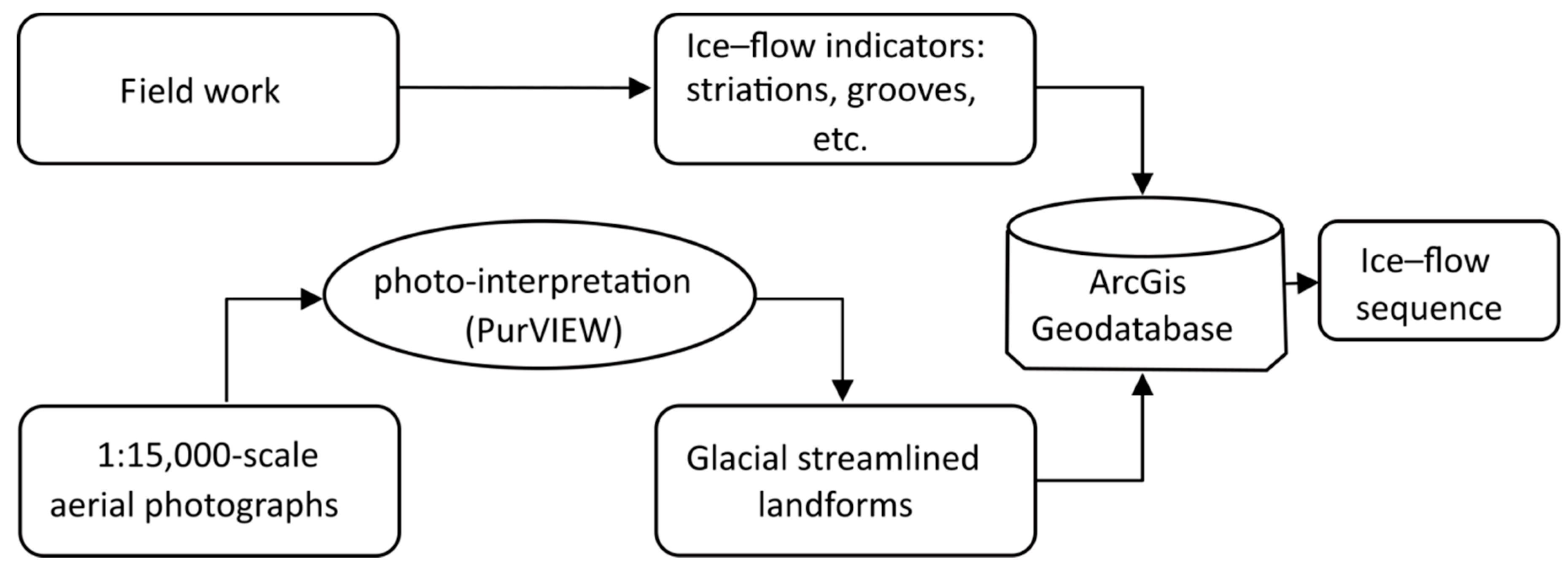
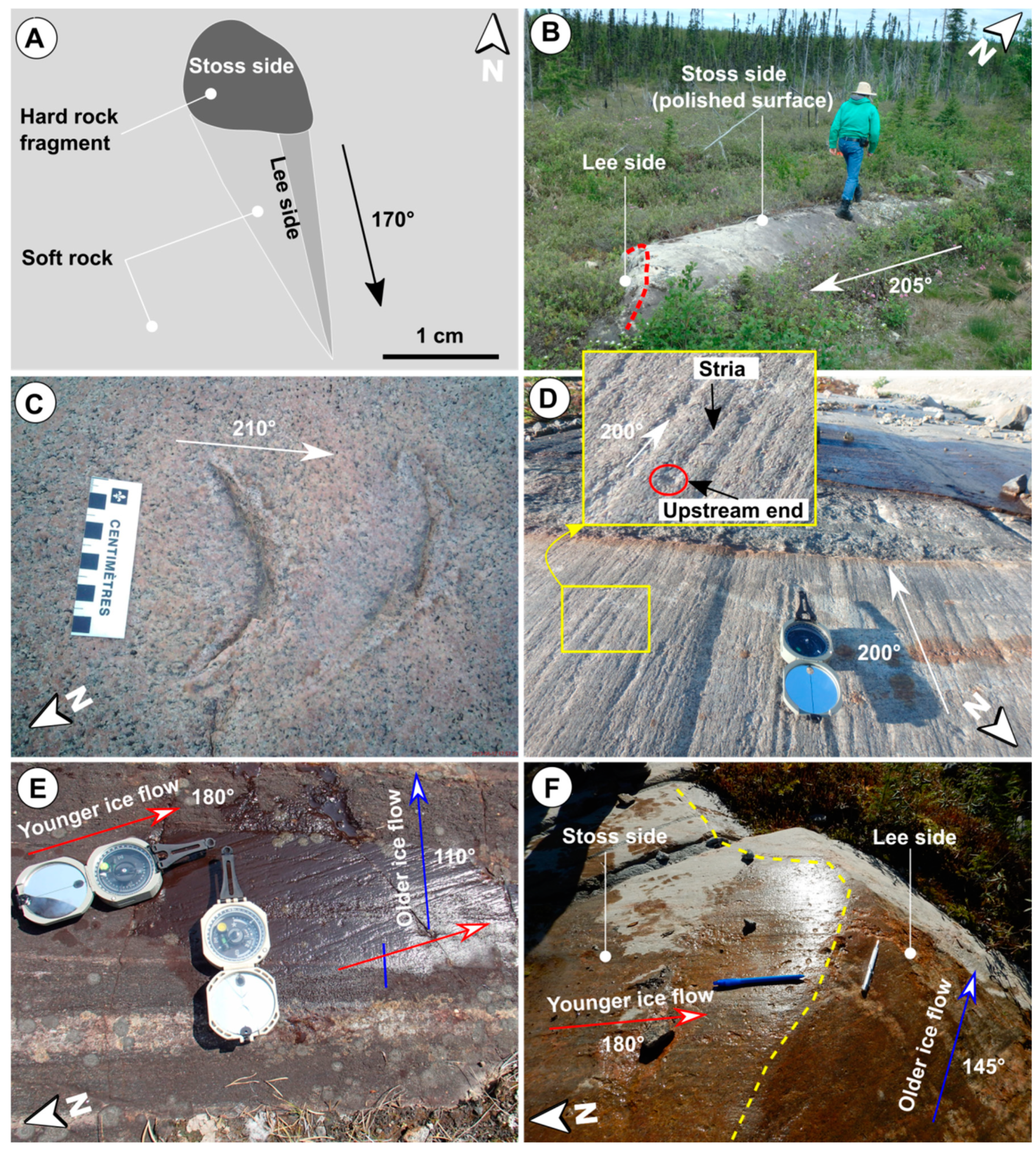
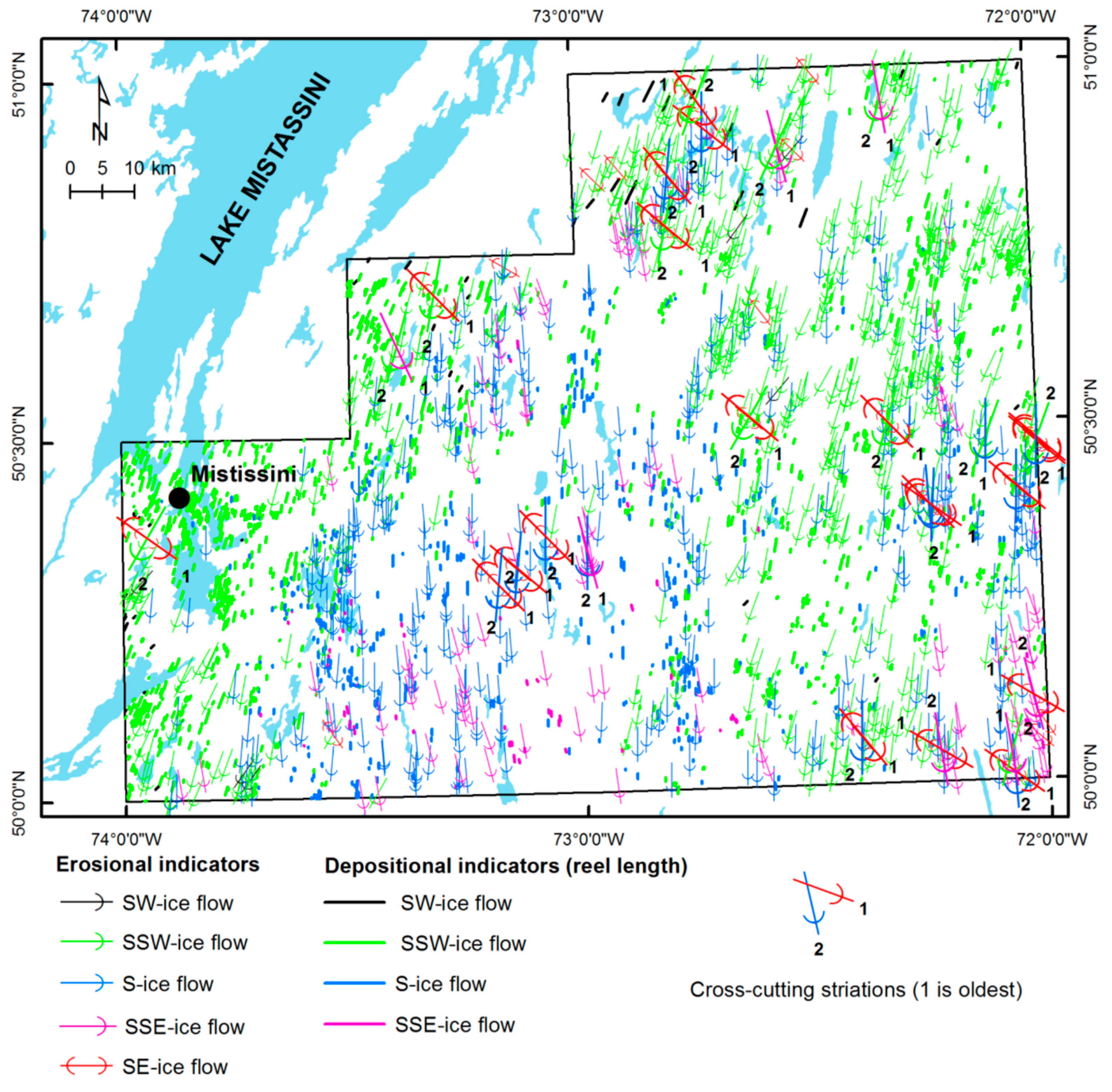
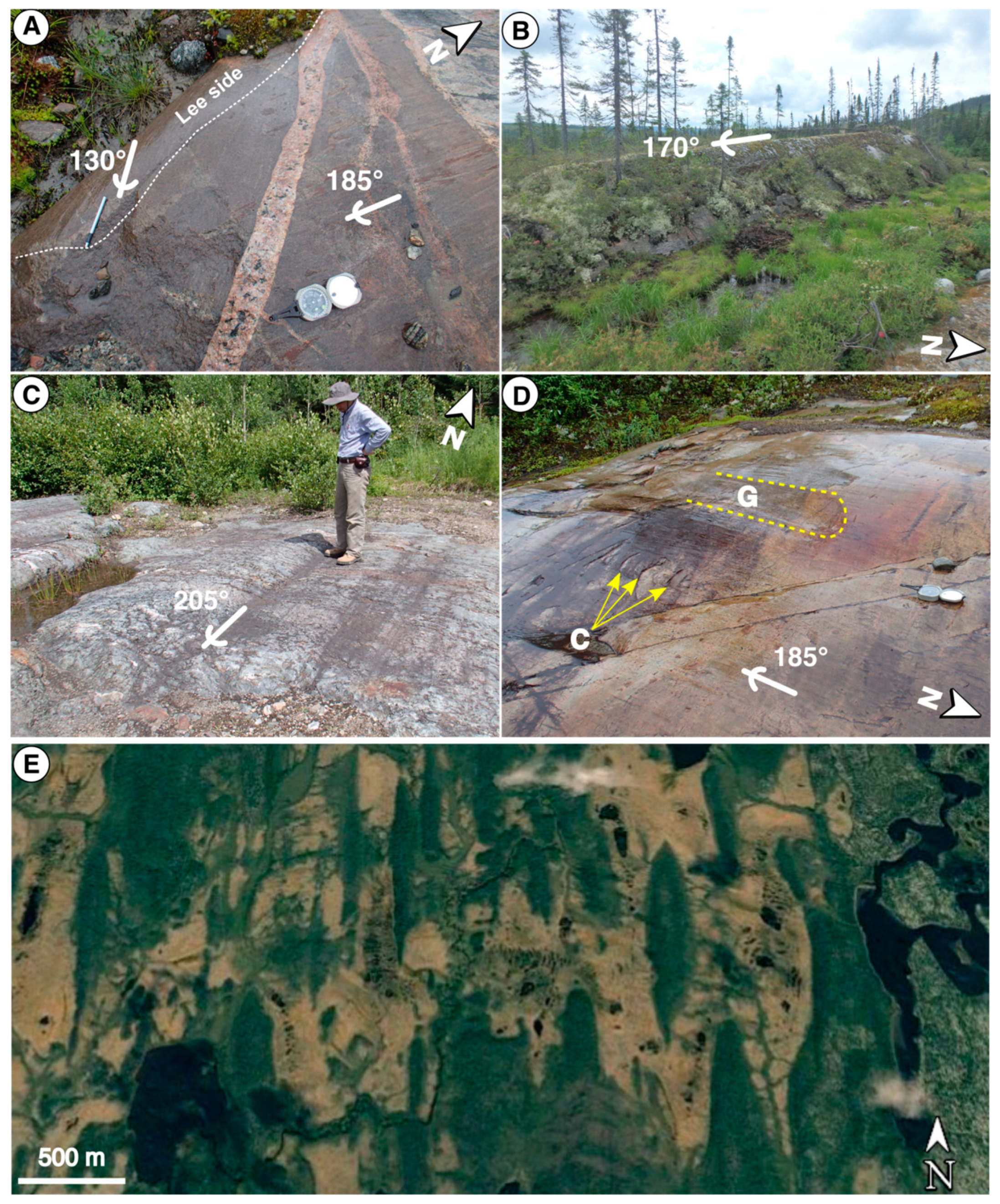

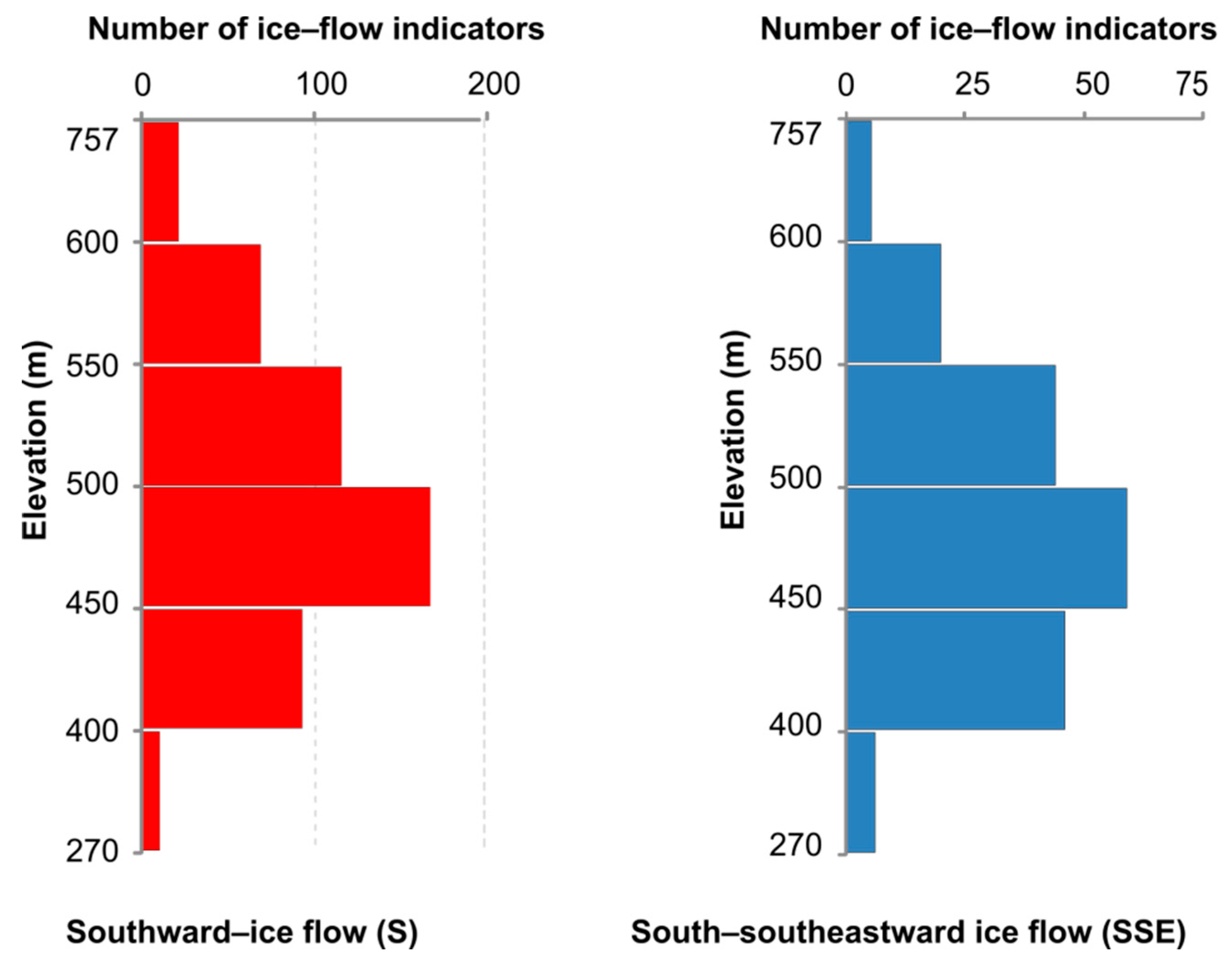

| Count | Type | Class |
|---|---|---|
| 979 | Striations | Erosional indicators |
| 40 | Grooves | |
| 6 | Crescentic gouges | |
| 5 | Whaleback features | |
| 113 | Drumlins | Depositional indicators |
| 1476 | Drumlinoids | |
| 195 | Crag-and-tails |
Disclaimer/Publisher’s Note: The statements, opinions and data contained in all publications are solely those of the individual author(s) and contributor(s) and not of MDPI and/or the editor(s). MDPI and/or the editor(s) disclaim responsibility for any injury to people or property resulting from any ideas, methods, instructions or products referred to in the content. |
© 2024 by the authors. Licensee MDPI, Basel, Switzerland. This article is an open access article distributed under the terms and conditions of the Creative Commons Attribution (CC BY) license (https://creativecommons.org/licenses/by/4.0/).
Share and Cite
El Amrani, M.; Diani, K.; Hamza, M.H.; Elhag, M.; Courba, S.; Amine, A.; Ben Driss, M.A.; Ousaid, L.; Mdiker, N.; Hahou, Y.; et al. Reconstructing the Relative Ice-Flow Chronology South of Lake Mistassini in Canada from New Ice-Flow Indicator Mapping. Limnol. Rev. 2024, 24, 450-465. https://doi.org/10.3390/limnolrev24040026
El Amrani M, Diani K, Hamza MH, Elhag M, Courba S, Amine A, Ben Driss MA, Ousaid L, Mdiker N, Hahou Y, et al. Reconstructing the Relative Ice-Flow Chronology South of Lake Mistassini in Canada from New Ice-Flow Indicator Mapping. Limnological Review. 2024; 24(4):450-465. https://doi.org/10.3390/limnolrev24040026
Chicago/Turabian StyleEl Amrani, Mohamed, Khadija Diani, Mohamed Hafedh Hamza, Mohamed Elhag, Said Courba, Afaf Amine, Moulay Ahmed Ben Driss, Lahcen Ousaid, Nabil Mdiker, Youssef Hahou, and et al. 2024. "Reconstructing the Relative Ice-Flow Chronology South of Lake Mistassini in Canada from New Ice-Flow Indicator Mapping" Limnological Review 24, no. 4: 450-465. https://doi.org/10.3390/limnolrev24040026
APA StyleEl Amrani, M., Diani, K., Hamza, M. H., Elhag, M., Courba, S., Amine, A., Ben Driss, M. A., Ousaid, L., Mdiker, N., Hahou, Y., & Boudad, L. (2024). Reconstructing the Relative Ice-Flow Chronology South of Lake Mistassini in Canada from New Ice-Flow Indicator Mapping. Limnological Review, 24(4), 450-465. https://doi.org/10.3390/limnolrev24040026








